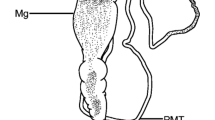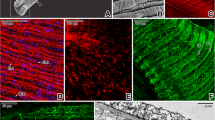Abstract
In arachnids, the Malpighian tubules (MTs), coxal glands and stercoral pockets are capable of collecting and removing excreta from the body. The presence of the MTs among Opiliones was evidenced for the first time in Amilenus aurantiacus in 2015. Individuals undergo a winter diapause subterranean habitats. Here, we provided the morphological and cytological description of the MTs and asked whether their structure and ultrastructure change during the winter diapause. We studied the changes using light and transmission electron microscopy. The MTs consisted of the ureter and a pair of long, lateral blind-ended tubules, forming a long loop in the opisthosoma, and a coiled, terminal ball in the prosoma. The MTs were uniform, composed of a single-cell type, a monolayer of cuboidal epithelial cells, and the basal lamina. The cell ultrastructure was quite comparable to those in other arthropods, except for very long infoldings of the basal membrane protruding close to the nucleus. Except for spherite exploitation, no changes were observed in the ultrastructure of the MT epithelial cells during overwintering. We suggest that the analogous MTs in A. aurantiacus, and the nephron anatomies, along with a single-cell-type MT epithelium, might be of advantage in modelled studies of the nephron.





Similar content being viewed by others
References
Baker GT, Krantz GW (1985) Structure of the male and female reproductive and digestive systems of Rhizoglyphus robini Claparède (Acari, Acaridae). Acarologia 26:55–65
Berridge MJ, Oshman JL (1972) A structural basis for fluid secretion by Malpighian tubules. Tissue Cell 1:247–272
Besenhofer LM, McLaren MC, Latimer B, Bartels M, Filary MJ, Perala AW, McMartin KE (2011) Role of tissue metabolite accumulation in the renal toxicity of diethylene glycol. Toxicol Sci 123:374–383. https://doi.org/10.1093/toxsci/kfr197
Beyenbach KW, Skaer H, Dow JAT (2010) The development, molecular, and transport biology of Malpighian tubules. Annu Rev Entomol 55:351–374. https://doi.org/10.1146/annurev-ento-112408-085512
Bourne, J.D., 1978a. Données préliminaires sur l’écologie et la biologie de l’opilion trogloxène Amilenus aurantiacus (Simon). Actes 6e Congrès Suisse de Spéléologie. Porrentruy, 17−24.
Bourne JD (1978b) Observations préliminaires sur l’intestin de l’opilion trogloxène Amilenus aurantiacus (Simon) pendant son sejour souterrain. Mém. Biospéol. 8:39–42
Bradley TJ (1985) The excretory system: structure and physiology. In: Kerkut GA, Gilbert LI (eds) Comprehensive insect physiology, biochemistry and pharmacology. Pergamon Press, New York, pp 421–465
Bradley TJ (2008) Active transport in insect recta. J Exp Biol 211:835–836. https://doi.org/10.1242/jeb.009589
Bradley TJ (2009) Excretion. In: Resh VH, Carde RT (eds) Encyclopedia of insects, 2nd edn. Academic Press, San Diego, pp 334–339
Chapman RF (2008) The insects: structure and function. Cambridge University Press, New York, pp 478–508
Chen YH, Liu HP, Chen HY, Tsai FJ, Chang CH, Lee YJ, Lin WY, Chen WC (2011) Ethylene glycol induces calcium oxalate crystal deposition in Malpighian tubules: a Drosophila model for nephrolithiasis/urolithiasis. Kidney Int 80:369–377. https://doi.org/10.1038/ki.2011.80
Chen WC, Lin WY, Chen HY, Chang CH, Tsai FJ, Man KM, Shen JL, Chen YH (2012) Melamine-induced urolithiasis in a Drosophila model. J Agric Food Chem 60:2753–2757. https://doi.org/10.1021/jf204647p
Cohen E, Sawyer JK, Peterson NG, Dow JAT, Fox DT (2020) Physiology, development, and disease modeling in the Drosophila excretory system. Genetics 214:235–264
Dow JAT (2009) Insights into the Malpighian tubule from functional genomics. J Exp Biol 212:435–445
Foelix RF (1996) Biology of spiders. In: Oxford University Press, G. Thieme Verlag, New York, Oxford
Furtado WCA, Azevedo DO, Martins GF, Zanuncio JC (2013) Histochemistry and ultrastructure of urocytes in the pupae of the stingless bee Melipona quadrifasciata (Hymenoptera: Meliponini). Microsc Microanal 19:1502–1510
Gillott, C., 2005. Entomology: The Third Edition. Springer, Netherlands.
Giribet G, Edgecombe GD (2019) The phylogeny and evolutionary history of arthropods. Curr Biol 29:592–602. https://doi.org/10.1016/j.cub.2019.04.057
Green LBS (1979) The fine structure of the light organ of the New Zealand glow-worm Arachnocampa luminosa (Diptera: Mycetophilidae). Tissue Cell 11:457–465
Hazelton SR, Felgenhauer BE, Spring JH (2001) Ultrastructural changes in the Malpighian tubules of the house cricket, Acheta domesticus, at the onset of diuresis: a time study. J Morphol 247:80–92. https://doi.org/10.5038/1827-806X.41.2.5
Jequier J-P (1964) Étude écologique et statistique de la faune terrestre d’une caverne du Jura Suisse au cours d’une année d’observations. Rev Suisse Zool 71:13–370
Kaestner A (1969) Lehrbuch der Spezielen Zoologie. In: I: Wirbellose. Jena, Gustav Fischer Verlag, 898 pp
Kalender Y, Kalender S, Candan S (2002) Fine structure of Malpighian tubules in the Agrotis segetum (Lepidoptera: Noctuidae) pupae. Acta Zool Bulg 54:87–96
Köhler H-R, Alberti G (1992) The effect of heavy metal stress on the intestine of Diplopods. Berichte des natur-medizinishes Vereins Innsbruck. Suppl 10:257–267
Landry GM, Hirata T, Anderson JB, Cabrero P, Gallo CJ et al (2016) Sulfate and thiosulfate inhibit oxalate transport via a dPrestin (Slc26a6)-dependent mechanism in an insect model of calcium oxalate nephrolithiasis. Am J Physiol Ren Physiol 310:152–159. https://doi.org/10.1152/ajprenal.00406.2015
Lipovšek S, Letofsky-Pabst I, Novak T, Hofer F, Pabst MA (2009) Structure of the Malpighian tubule cells and annual changes in the structure and chemical composition of their spherites in the cave cricket Troglophilus neglectus Krauss, 1878 (Rhaphidophoridae, Saltatoria). Arthropod Struct. Dev. 38:315–327. https://doi.org/10.1016/j.asd.2009.02.001
Lipovšek S, Novak T, Janžekovič, Leitinger G (2015) Changes in the midgut diverticula in the harvestmen Amilenus aurantiacus (Phalangiidae, Opiliones) during winter diapause. Arthropod Struct Dev 44:131–141. https://doi.org/10.1016/j.asd.2014.12.002
Lipovšek S, Novak T, Janžekovič F, Weiland N, Leitinger G (2016) Malpighian tubule cells in overwintering cave crickets Troglophilus cavicola (Kollar, 1833) and T. neglectus Krauss, 1879 (Rhaphidophoridae, Ensifera). PLoS One 11(7):e0158598
Lipovšek S, Janžekovič F, Novak T (2017) Ultrastructure of fat body cells and Malpighian tubule cells in overwintering Scolyopterix libatrix (Noctuoidea). Protoplasma 254:2189–2199. https://doi.org/10.1007/s00709-017-1110-3
Martens J (1969) Systematische Stellung von Amilenus aurantiacus (Simon) (Opiliones, Phalangiidae). Senckenberg Biol 50(3/4):219–224
Martens J (1978) Weberknechte, Opiliones. In: Die Tierwelt Deutschlands 64. Fischer, Verlag
Martoja R, Ballan-Dufrançais C (1984) The ultrastructure of the digestive and excretory organs. In: King RC, Akai H (eds) Insect ultrastructure. Plenum, New York, pp 199–268
Mello ML (1979) A mucous secretion in the Malpighian tubes of a neotropical bumblebee, Bombus atratus Franklin. Protoplasma 99:147–158
Mello ML, Kerr WE (1984) Histochemistry of salivary gland and Malpighian tubule secretions contributing to the cocoon in Plebeia droryana and Scaptotrigona postica (Hym., Apoidea). Zool Anz 213:177–189
Nocelli RCF, Cintra-Socolowski P, Roat TC, Silva-Zacari ECM, Malaspina O (2016) Comparative physiology of Malpighian tubules: form and function. Open Access Insect Physiol 6:13–23. https://doi.org/10.2147/OAIP.S72060
Novak T, Gruber J, Slana L (1984) Remarks on Opiliones from cavities in Slovenia (Yugoslavia). Mém Biospéol 11:185–197
Novak T, Perc M, Lipovšek S, Janžekovič F (2012) Duality of terrestrial subterranean fauna. Int J Speleol 41(2):181–188
Novak T, Janžekovič F, Lipovšek S (2013) Contribution of non-troglobiotic terrestrial invertebrates to carbon input in hypogean habitats. Acta Carsologica 42(2-3):301–309
Pal R, Kumar K (2013) Malpighian tubules of adult flesh fly, Sarcophaga ruficornis fab. (Diptera: Sarcophagidae): an ultrastructural study. Tissue Cell 45(5):312–317
Pannabecker T (1995) T. Physiology of the Malpighian tubule. Annu Rev Entomol 40:493–510
Paulus HF (2004) Einiges zur Stammesgeschichte der Spinnentiere (Arthropoda, Chelicerata). In: Thaler K (ed) Diversität und Biologie von Webspinnen, Skorpionen und anderen Spinnentieren. Denisia, vol 12, pp 547–574
Santos FH (2007) Ecophysiology. In: Pinto-da-Rocha R, Machado G, Giribet G (eds) Harvestmen. The biology of opiliones. Harvard University Press, Cambridge, pp 473–488
Seitz, K.A., 1987. Excretory organs. In: Nentwig, W. (Ed.), Ecophysiology of spiders. Springer. pp. 239–248.
Shultz JW (1990) Evolutionary morphology and phylogeny of Arachnida. Cladistics 6:1–38
Shultz JW, Pinto-da-Rocha R (2007) Morphology and functional anatomy. In: Pinto-da-Rocha R, Machado G, Giribet G (eds) Harvestmen. The biology of opiliones. Harvard University Press, Cambridge, pp 14–61
Wenning A, Greisinger U, Proux JP (1991) Insect-like characteristics of the Malpighian tubules of a non-insect: fluid secretion in the centipede Lithobius forficatus (Myriapoda: Chilopoda). J Exp Biol 158:165–180
Yu CH (2003) Ultrastructure of the Malpighian tubule cells in the mosquito larvae, Anopheles sinensis. Korean J Entomol 33:151–159
Acknowledgements
We sincerely thank Elisabeth Bock und Rudi Schmied (Medical University Graz) for their excellent technical assistance. Michelle Gadpaille valuably improved the English of the manuscript. Helpful suggestions of the Editor and Reviewers are highly appreciated.
Funding
This study was partly supported by the Slovenian Research Agency within the Biodiversity Research Programme (Grant No. P1-0078) and by grant ‘Infrastrukturni program’ University of Maribor (IP-0552).
Author information
Authors and Affiliations
Contributions
SL and TN designed the study and wrote the original draft. SL, TN and PK acquired light microscopy images. SL and GL acquired TEM images. All the authors revised and approved the final version.
Corresponding author
Ethics declarations
Competing interests
The authors declare no competing interests.
Additional information
Handling Editor: Handling Editor: Margit Pavelka
Publisher’s note
Springer Nature remains neutral with regard to jurisdictional claims in published maps and institutional affiliations.
Highlights
• Malpighian tubules (MTs) are described for the first time in Opiliones
• In Amilenus, the MTs consist of the ureter and a pair of long, blind-ended tubules
• The MTs are unitary over the whole length, composed of a single-cell type
• Apart from the exploitation of spherites, the MTs do not change during the diapause
• The one-cell type of MT might offer some advantage in nephron modelling
Rights and permissions
About this article
Cite this article
Lipovšek, S., Kozel, P., Leitinger, G. et al. Malpighian tubules in harvestmen. Protoplasma 258, 1145–1153 (2021). https://doi.org/10.1007/s00709-021-01634-0
Received:
Accepted:
Published:
Issue Date:
DOI: https://doi.org/10.1007/s00709-021-01634-0




